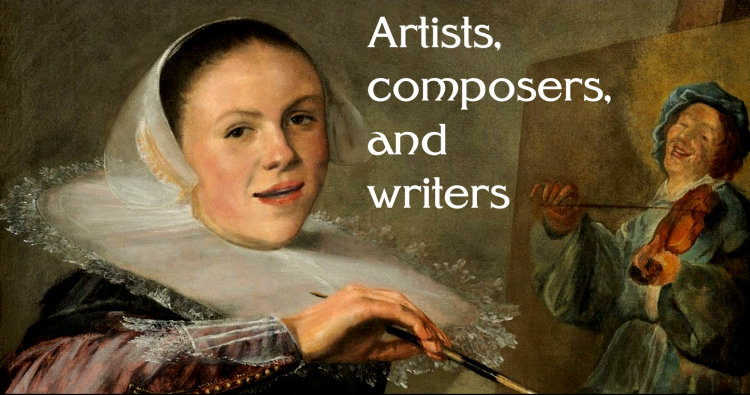2. It's in the Details.
Contrary to the usual accounts, which look to Italy as the locus for the most interesting artistic developments in the
1400s, the work produced North of the Alps was often richer, more complex, and more technically sophisticated. Bruges,
in fact, was the most important commercial center in Europe, and the art produced and sold there was greatly admired,
including by Italian patrons. The comparative lack of attention to the arts of the North may be because they grew more
seamlessly out of medieval practice, but declined earlier than in Italy. They were often collaborative, involving a
variety of media. They were valued for different qualities. And many works were lost or destroyed in the Protestant
Reformation.
Northern paintings of the 15th century typically have much more detail than their Italian counterparts: detail in the
faces; detail in the setting; detail in the textures of hair, fur, and brocade; detail in the numerous objects which carry
symbolic significance. Such detail in Northern painting was made possible by the use of oil paint, a technique not
introduced into Italy until late in the century. We shall look at such artists as the Limbourg Brothers, Jan van Eyck,
Hugo van der Goes, Hans Memling, and in the next century Albrech Dürer and Pieter Bruegel. Plus a bunch of wonderful
music by Franco-Flemish composers who were in demand all over Europe.
The script, videos, and images will be posted immediately after class.
Here are brief bios of the artists and poets considered in the class, listed in chronological order of birth.
You can access all biographies via the BIOS link on the syllabus page.
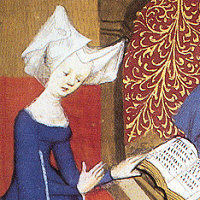 |
Christine de Pizan, 1364–1430. French poet.
Born in Venice, Christine moved to Paris as a child, when her father became astrologer to the king. She married a court official, then had to support herself by her writing after he died. She wrote poetry and prose in most genres, and is credited as being the first female professional writer of modern times.
|
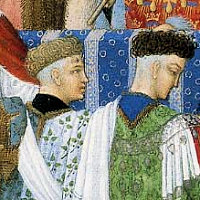 |
Limbourg Brothers (Herman, Paul, Johan), 1385–1416. Netherlandish manuscript illuminators.
Little is known of their earlier lives, but all three worked for Philip the Bold of Burgundy, and his brother Jean, Duc de Berry, for whom they produced the Très riches heures. [I have no reason to suppose that these are self-portraits, but we have no other!]
|
 |
Jan van Eyck, 1390–1441. Netherlandish painter.
The most celebrated and influential northern painter in the earlier15th century, responsible for developing a style of oil painting capable of magnificent detail and effects of light. His major work, the altarpiece in Ghent Cathedral, is recorded to have been begun by his perhaps even greater brother Hubert.
|
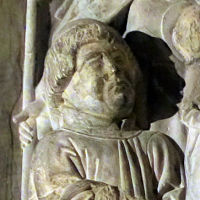 |
Guillaume Dufay, 1397–1474. Franco-Flemish composer.
Dufay (also spelled Du Fay and other variants) was born near Brussels. Writing in most genres and traveling widely, he was regarded as the leading composer of his time, composing for example the mass for the dedication of Brunelleschi's dome of Florence Cathedral. [The portait comes from his tomb.]
|
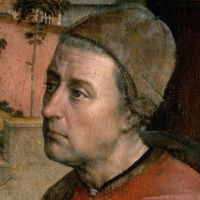 |
Rogier van der Weyden, 1399–1464. Netherlandish painter.
Very little is known of Rogier's life, except that he was highly successful in his time, with his works exported to Italy and Spain, and commissioned by princes both in the Netherlands and abroad. His extraordinary detail and emotionally intense compositions now place him firmly with Jan van Eyck and Robert Campin in the trinity of early Netherlandish masters.
|
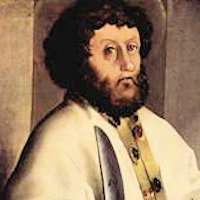 |
Konrad Witz, 1400–46. German painter.
Witz was born in Germany, but was active most of his life in Switzerland. "His 1444 panel The Miraculous Draft of Fishes (a portion of a lost altarpiece) has been credited as the earliest extant faithful portrayal of a landscape in European art history, being based on observation of real topographical features" [Wikipedia]. The thumbnail shows a detail from one of his religious paintings; it is not necessarily a self-portrait.
|
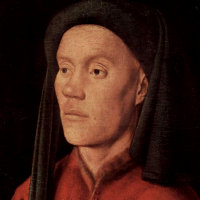 |
Gilles Binchois, 1400–60. Franco-Flemish composer.
Binchois was praised by his contemporaries in the same breath as Dufay, though his fame has declined somewhat. He is especially memorable as a melodist, with a gift for the long expressive line in both his secular and sacred vocal work. [He may or may not be the subject of this portrait by Jan van Eyck.]
|
 |
Johannes Ockeghem, 1430–1497. Franco-Flemish composer.
Writing both sacred and secular vocal music, he was one of the leading musicians of the late 15th century.
|
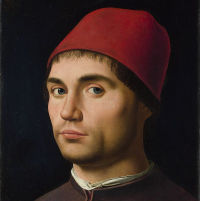 |
Antonello da Messina, 1430–79. Sicilian painter.
He probably learned the secrets of Netherlandish oil-painting technique because of contacts between the Netherlands and Naples. And in his visit to Venice in 1475–76, he would have passed these on to local artists, explaining some the qualities of light and color that distinguished Venetian art .
|
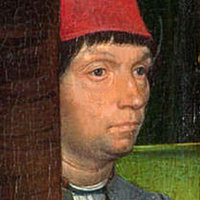 |
Hans Memling, 1430–94. Netherlandish painter.
Based in Bruges, and probably a pupil of Rogier van der Weyden, he developed a sweeter more balanced version of his style which brought him great success. Also spelled "Memlinc."
|
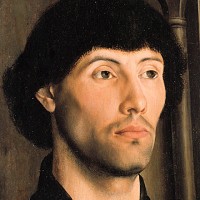 |
Hugo van der Goes, 1435–1482. Netherlandish painter.
The major figure of the second half of the 15th century in the Netherlands, he is known for his psychological observation and the richness of his backgrounds, as in the Portinari Altarpiece which introduced his style to Florence. [Identificaton of this as a self-portrait is conjectural.]
|
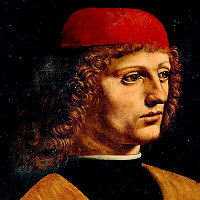 |
Josquin des Prez, 1440–1521. Franco-Flemish composer.
Josquin is considered one of the leading composers in the High Renaissance, and not just in the Franco-Flemish school. Almost all his works are vocal, mostly sacred. He is credited with breaking away from the tradition of long melismatic lines, writing instead in short imitative phrases that are closely expressive of the text. [This portrait of a musician by Leonardo da Vinci has not definitely been identified as Josquin, although both were in Milan at the same time.]
|
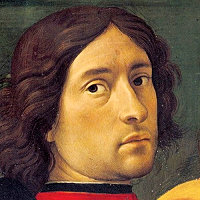 |
Domenico Ghirlandaio, 1449–94. Florentine painter.
In the same generation as Botticelli, Pollaiuolo, and Verrochio, Ghirlandaio achieved success through his ability to execute large-scale subjects that often included portraits of his wealthy patrons. He was also a remarkably sensitive in his independent portraits, including the famous Old Man and his Grandson in the Louvre. Michelangelo was one of his pupils.
|
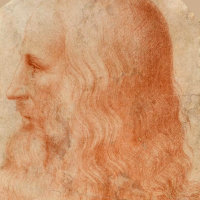 |
Leonardo da Vinci, 1452–1519. Italian painter and polymath.
With Michelangelo and Raphael, one of the triumvirate of artistic geniuses that crown the High Renaissance. He trained in Florence with the painter Andrea Verrocchio before moving to the court of Ludovico Sforza in Milan. He spent the last years of his life at the court of François I in France. The naturalism and luminosity of his painting, and his effects of sfumato (or modeling as if by smoke), were widely influential. It is his notebooks, however, that are the best testament to the range of his genius, containing remarkable observations of the natural world, and mechanical inventions centuries before their time.
|
 |
Albrecht Dürer, 1471–1528. German printmaker and painter.
The greatest German draughtsman of the Renaissance and a formidable intellect, he produced an astonishing series of woodcuts and engravings throughout his career, as well as a number of devotional paintings and portraits, plus numerous sketches and watercolors that testify to his extraordinary powers of observation.
|
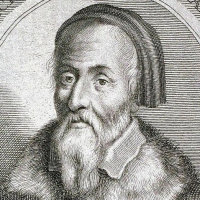 |
Albrecht Altdorfer, 1480–1538. German painter and engraver.
Working most of his life in Regensburg in the Danube valley, he was one of the first German painters to take an interest in landscape, including the forests which often figure in his works.
|
 |
Martin Luther, 1483–1546. German theologian and composer.
Ordained a priest in 1507, and immediately began his work as a scholar, preacher, and writer. Wishing merely to start academic debate, in 1517 he posted his Ninety-Five Theses on the church door at Wittenberg. But this sparked the Protestant revolution, and in 1521 Luther was excommunicated. Contrary to the teachings of his time, he preached that the Bible, not the Church, was the ultimate spiritual authority, and indeed was one of the first to translate the entire Bible into German, so that it could be accessed by ordinary people. He also wrote a large number of hymns, both text and music.
|
 |
Clément Janequin, 1485-1558. French composer.
Most of Janequin's large output consisted of secular chansons, often with striking onomatopoeic imitation of their subjects, which made him exceptionally popular in his day.
|
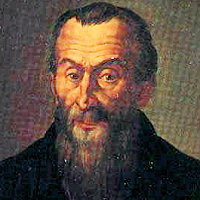 |
Adrian Willaert, 1490–1562. Netherlandish composer.
Willaert's music traveled to Italy before he hiself did, at the age of 25. But that was where he spent the rest of his career, in court appointments in Ferrara and Milan, and latterly as maestro di cappella of St. Mark's at Venice, becoming the founder of an important musical tradition that was to last through the 17th century. He also composed many secular compositions to Italian texts.
|
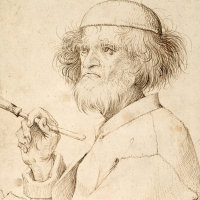 |
Pieter Bruegel the Elder, 1525–69. Netherlandish painter.
Considered the greatest Northern European painter of his time, he produced mainly moralistic works characterized by their high viewpoint and close observation of ordinary people. Also spelled "Brueghel" and "Brughel."
|

























































